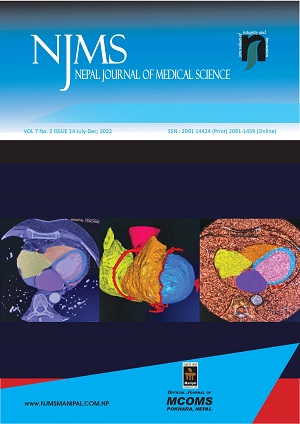Cardiac Evaluation of Chronic Kidney Disease Patients under Maintenance Hemodialysis
DOI:
https://doi.org/10.3126/njms.v7i2.47242Keywords:
Echocardiography, Electrocardiography, Renal DialysisAbstract
Introduction: Chronic kidney disease (CKD) patients are at increased risk of morbidity and mortality because of their native disease progression. Accumulation of other atherosclerotic risk factors associated with CKD multiplies their risks. This study aimed to evaluate cardiac structural and functional abnormalities in CKD patients undergoing Maintenance Hemodialysis (MHD) using Electrocardiography (ECG) and Echocardiography (Echo).
Method: It was a prospective cross-sectional study containing all CKD patients undergoing MHD at Pokhara Academy of Health Sciences, Pokhara, Nepal was conducted between August 2020 to December 2020. All the relevant data were entered in Statistical Package for Social Science (SPSS) for analysis.
Results: There was a total of 115 patients with a male: female ratio of 1.8:1 and a mean age of 47.25 ± 15.20 years. The mean duration of dialysis was 36 months and hypertension was the prime risk factor. Common ECG abnormalities were left ventricular hypertrophy, left ventricular strain pattern and poor R wave progression. Common Echo abnormalities were left ventricular diastolic dysfunction, left ventricular hypertrophy and regurgitation. Left ventricular systolic dysfunction was present in 20% of the patients.
Conclusion: A spectrum of structural and functional cardiac abnormalities is common in CKD patients undergoing MHD. Early measures should be adopted to mitigate the risk.
Downloads
Downloads
Published
How to Cite
Issue
Section
License
Copyright (c) 2022 Nepal Journal of Medical Sciences

This work is licensed under a Creative Commons Attribution 4.0 International License.
Copyright © by Nepal Journal of Medical Sciences. The ideas and opinions expressed by authors of articles summarized, quoted, or published in full text in this Journal represents only opinions of authors and do not necessarily reflect the official policy of Nepal Journal of Medical Sciences or the institute with which the author(s) is (are) affiliated, unless so specified.




